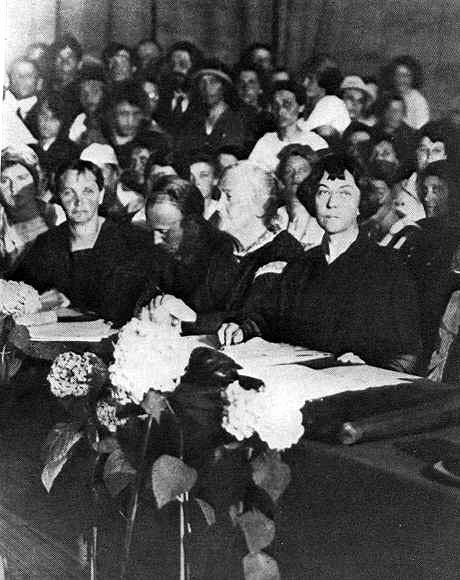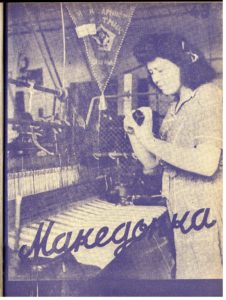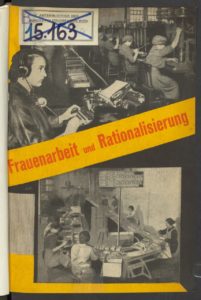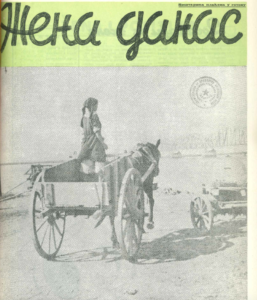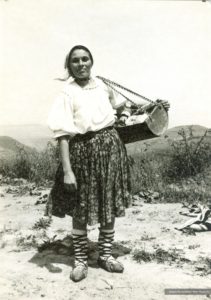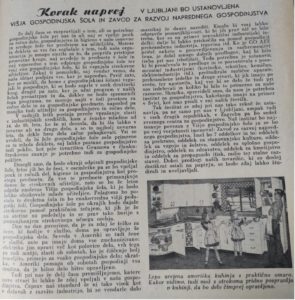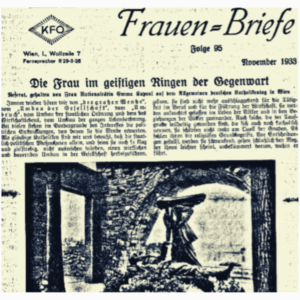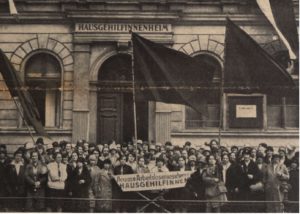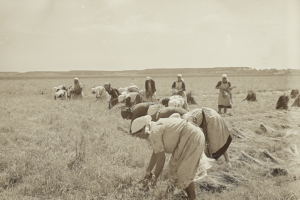by Minja Bujaković
On a summer night in 1920, the halls of the Bolshoi Theatre in Moscow echoed with the sound of The Internationale: communist women stood up singing in harmony, marking the opening of the First International Conference of Communist Women. Taking place between July 30 and August 2, 1920, the conference gathered activist women from various countries, establishing ties among them, and slowly constructing the network of the future international Communist Women’s Movement (CWM).
This is how Polina Vinogradskaya, a member of Zhenotdel [Women’s Department] and one of the editors of the journal Kommunistka (1920-1930) [Communist Woman] depicted the conference in her report, written to preserve memories of an ostensibly historic event for the future movement.[1] A different description appears in the letter sent by Rosi Wolfstein, a German delegate, to her friend Clara Zetkin. Her description conveys the impression of the Conference not as a grandiose international gathering of communist women, but as a gathering of women delegates present at the concurrent Second World Congress of the Communist International (Comintern).[2]
The explanation of the conflicting depictions lies in different focal points: while Wolfstein focused on the number of delegates, possibly mentioning it to Zetkin as a critique of the Comintern’s lack of interest in this event, Vinogradskaya focused on the crowd of working women attending the conference.[3] The comparison of the delegates lists from the two events, with just a few inconsistencies, supports Wolfstein’s statement, showing that the Conference gathered a meager number of international delegates in comparison to 217 delegates coming to Moscow to attend the Comintern Congress. The discrepancies in the delegates’ lists occur in a few cases.[4] But what both lists obliterate are other conference attendees, more numerous, and seemingly less important ones – exactly those Vinogradskaya describes – working women.
Nonetheless, it was not the number of delegates and their expertise, nor the number of working women that marked this Conference, but the absence of the most experienced international activists – Clara Zetkin and Alexandra Kollontai. The absence of the “leaders of the international communist women’s movement”, as Vinogradskaya referred to them, was addressed at the very beginning of the Conference. While Kollontai was absent due to serious health issues, the reasons behind Zetkin’s absence were less clear. Rosi Wolfstein addressed this issue in her first speech at the conference, vaguely stating that Zetkin was prevented to come due to her party assignments in Germany.[5] Still, the Conference sent two telegrams: one to the “vozhd” and “pioneer of the international proletarian women’s movement” – Clara Zetkin, and the other, to “the experienced fighter for freedom of working women” – Alexandra Kollontai.[6] These telegrams reaffirmed the status of two activists, situating them at the core of the emerging movement.
Kollontai’s and Zetkin’s absence was anticipated already in December 1919. Hence, the Executive Committee of the Communist International (ECCI) appointed Inessa Armand to organize the first international gathering of communist women.[7] Despite her undeniable skills and knowledge, it seems that Armand’s work was hindered by the institutional marginalization of the work on communist women’s organizing, and her weak position in the international activist network. The institutional marginalization was manifested through comrades’ paternalistic attitudes towards women, and the lack of financial support for their activism.[8] For instance, Armand was given almost no financial support to gather attendees who would not happen to be in Moscow as participants of the Comintern Congress.[9]
The lack of financial support meant Armand could not amplify her outreach in the international arena. The problem of the international communication between her and communist women in various countries came to be blatantly obvious. In her report given at the All-Russian Meeting of the Organizers of Zhenotdels, held in March, she highlighted that there was next to no communication with foreign communist and socialist women’s movements.[10] Armand did make an effort to overcome this communicational gap by sending a letter, already in January 1920, to the national parties belonging to the Comintern. She described the international conference of communist women as a precondition for the development of a successful strategy to politically organize.[11] Yet, due to the considerable communicational challenges of the period, the possible lack of national parties’ interest in the event, and her weak position in the international network, her plea did not meet with a generous response.
Despite all obstacles, the conference did take place, bringing an unequivocal conclusion: in all places, across borders, women found themselves in a terrible position after the war. The undeniable change in everyday life including the loss of family members, high child mortality, mass unemployment, famine, lack of housing, and the rise of prices further deteriorated working women’s lives throughout the world.[12] Such a position, arguably, evoked the revolutionary spirit of working women, that was now to be used and directed into the common struggle of the proletariat. On these waves of revolutionary sentiments, the conference published the appeal “To the Working Women of the World” and adopted the Theses on the Work Among Women. Theses, drafted by Zetkin in 1920, and edited by conference delegates in Moscow, were sent to Zetkin for revision and published later in 1920.[13]
Zetkin’s Theses laid the ground for the CWM, primarily envisaging it as part of the Third International: comparing the Second International with the Third one, Zetkin argued that the
“Third International will not be a factory of resolutions in the struggle for women’s rights and women’s freedom either, but rather a community of action”.[14]
This network was imagined as a safe space in which communist women would meet, share experiences, and exchange ideas, later translating them to their national contexts. Accordingly, the Conference decided to establish a body – International Women’s Secretariat (IWS) – the main purpose of which would be a creation of a strong transnational network of collaboration among communist activists, that would serve as a base of this imagined community. The IWS was to have 3-7 members, serving as its main pillars, and consolidating the broader movement. The first ones to be elected were prominent activists: Nadezhda Krupskaya, Zlata Lilina, Konkordia Samoilova, Lyudmila Stal, Henriette Roland-Holst, Rosa Bloch, and Alexandra Kollontai, as a vice-secretary, and Clara Zetkin, as secretary.
The women chosen to lead the CWM knew each other from previous years of activism, turning their previous ties into the backbone of the new movement. The network of the new movement as such had the potential to retain old members and mobilize new ones. To operate and develop on a transnational level as imagined, the movement required a firm infrastructure.
The work on the infrastructure of the movement was taken up by its proclaimed leaders- Kollontai and Zetkin. From a letter Zetkin sent to Kollontai in February 1921, it becomes evident that Kollontai was active again, urging Zetkin to organize the second international conference. Zetkin, as rational as ever, tamed Kollontai’s enthusiasm, arguing that such an endeavor takes time and people. Just as Armand a year before, she highlighted the challenge of loose connections among activists on an international scale, which she tried to overcome by reaching out to her contacts in Austria, Czechoslovakia, France, England, and of course Germany.[15] Thus, Zetkin wisely used her position in the activist network: she had many contacts, and her contacts had even more contacts within national parties. Her position as such also allowed her to push for some issues, and work around institutional and material obstacles posed by Comintern.
The establishment of the organ of the CWM, the Die Kommunistische Fraueninternationale (1921-1925) [Communist Women’s International] proves this point. In the same letter to Kollontai, Zetkin advocated for the creation of an organ that was to help international diffusion and exchange of ideas and information among communist activists. Even though it was assumed that such an organ would emerge in Moscow after the first Conference, it still had not come into being by February 1921. Accordingly, Zetkin decided to, once again, use the power of her network, challenging the institutional oblivion of this task, and establish the organ this way. Working from Berlin as its main editor and publisher, Zetkin noted, left her hands relatively free.[16]
Only two months after this letter, in April 1921, the first issue of Die Kommunistische Fraueninternationale was published. The content of the first issue of the journal shows that its rapid publishing was a result of Zetkin’s networks: the first articles were swiftly written by her close friends and party comrades. This way, by using her personal network as a resource, Zetkin managed to create an organ of the CWM, providing the movement with a platform for the exchange of ideas and experiences. Three months later, after meticulous planning, the Second International Conference of Communist Women finally took place.[17] Its reports tell the story of the first year of the development of the international CWM.
But, until the story of the Second International Conference of Communist Women is recounted, the personal story of Clara Zetkin serves as an example, showing not only the power of individual actions or leadership skills but also the effect of collaboration of individuals in the creation of an international movement. A focus on individuals can offer, as highlighted in the introduction to this Blog Series, new perspectives on gendered labour struggles. Zetkin’s case demonstrates that CWM did not emerge in a vacuum or due to Comintern’s directives: It emerged as a network built on connections and collaboration of individual women, who gathered to struggle for working women’s rights and emancipation, exactly as it had been previously imagined: a community of action.
References:
[1] Международная конференция коммунисток. Отчет о Первой Международной конференции коммунисток [International Conference of Communist Women. Report on the First International Confrence of Communist Women] (Moscow, Государственное издательство,1921), 19. (From now on referred to as Report on the First Conference)
[2] Robert F Wheeler, “German Women and the Communist International: The Case of the Independent Social Democrats” Central European History 8, no. 2 (1975): 115. http://www.jstor.org/stable/4545737. Unfortunately, the general purpose of the letter remains unknown to me.
[3] A more detailed description of the working women attending the conference appears in the section of the memoirs of Vinogradskaya, published in the Journal Новый Мир (1925-) [New World]. In it, Vingradskaya describes gathered working women: “Immense empire of women. Loud, stirred, like the sea, splashing with the waves of red head scarves’’. Polina Vinogradskaya, “Памяатные встречи” [Memorable Encounters], Новый Мир 4 (April 1965):14. As the original letter of Rosi Wolfstein to Clara Zetkin is not available to me, it may only be assumed that Wolfstein, a close friend and party comrade of Zetkin, was supposed to inform Zetkin on the details of the conference that would be obliterated in the official reports, such as one written by Vinogradskaya.
[4] For example, delegates from Turkestan Karimova and Dvorkina were listed as delegates to the International Women’s Conference, but not as delegates to the Congress. Moreover, many of the women delegates from Russia attending the Communist Women’s Conference were not listed as Comintern Congress delegates. Lastly, the names of the men and women workers attending these events were not mentioned in the official delegates lists. The only information we have on women workers attending the conference appears in Vinogradskaya’s memoirs. Still, even Vinogradskaya does not mention their names, but only the names of the factories they worked in.
[5] Report on the First Conference, 24.
[6] Report on the First Conference, 22.
[7] R.C. Elwood, Inessa Armand. Revolutionary and Feminist (Cambridge, Cambridge University Press, 1992), 258.
[8] Armand seemed to be well aware of these restraints. As the president of the Zhenotdel, Armand had witnessed the paternalistic attitudes of her closest comrades, who saw Zhenotdel as a feminist deviation, and a threat to the general proletarian movement. As Michelle Jane Patterson shows in her Ph.D. thesis, the negative attitude towards the Zhenotdel was not expressed only by the male members of the party, but also by women comrades. She notes that Konkordia Samoilova, leader of Zhenotdel, claimed that work in the Zhenotdel was seen as work “beneath dignity”. Michelle Jane Patterson, “Red ‘Teaspoons of Charity’: Zhenotdel, the Communist Party and Russian Women, 1919-1930” ( Ph.D. Thesis, Department of History, University of Toronto, 2011), 25.
[9] R.C. Elwood, Inessa Armand. Revolutionary and Feminist (Cambridge, Cambridge University Press, 1992), 258.
[10] Inessa Armand, Статьи, Речи, Письма [Articles, Speeches, Letters] (Moscow, 1975):138, 139.
[11] According to the letter discussed by Jean Jacques Marie in his chapter on the Women’s Section of Comintern. Jean-Jacques Marie, “The Women’s Section of the Comintern, from Lenin to Stalin,”), Political and Historical Encyclopedia of Women, ed. Christine Fauré (New York, London: Routledge, 2005), 426.
[12] Report on the First Conference: 23.
[13] John Riddel, To the Masses: Proceedings of the Third Congress of the Communist International (Brill, 2015).
[14] Проект тезисов для женского коммунистического движения [The Project of the Thesis for the Communist Women’s Movement], fond 528, reel 6, description 1, file 1918, International Institute for Social History, Amsterdam, Netherlands, p.16.
[15] Letter (to Alexandra Kollontai) on a detailed plan of the preparation and conduction of the International Women’s Conference, on the formation of the printed organ of the International Women’s Movement and agreement of Clara Zetkin to edit it, February 1, 1921, Berlin, Fond 528, reel 13, description 2, file 25, International Institute for Social History, Amsterdam, Netherlands, 1.
[16] Ibid, 5.
[17] On the Second International Communist Women’s Conference see a blog post by Ivelina Masheva: https://zarah-ceu.org/ana-maimunkova-trials-and-tribulations-of-a-communist-activist/
Illustration: Clara Zetkin and Alexandra Kollontai at the Third Congress of the Communist International, 1921. Source: Unknown author, Public domain, via Wikimedia Commons.
Minja Bujaković is a second-year Ph.D. researcher at the European University Institute in Florence. In her project, she explores the transnational communist women’s movement in the interwar period. Her research interests are transnational women’s activism, labour history, history of communism, and historical network analysis.

